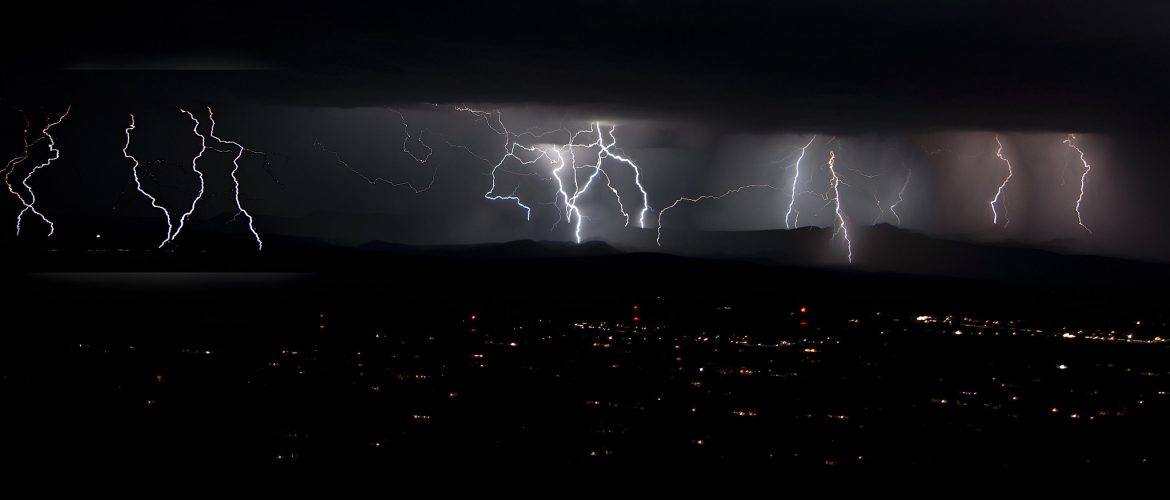SEIPS Tech Tips: Job Site Lightning Safety Considerations for Solar Professionals
by Brian Mehalic
Summer is here and SEI Professional Services (SEIPS) is hard at work in the field on job sites all over the country. We are ramping up a ton of client work performing commissioning, inspections, and O&M on large-scale solar projects and thought lightning safety would be a timely topic. Severe weather is often a nuisance because it can delay or cancel field work – which causes stress when there are tight deadlines – but the personal safety and the safety of your team should never be compromised.
Safety is priority #1 here at SEIPS as we are working with high-voltage solar photovoltaic (PV) systems, often connected to even higher-voltage electrical grids, often in harsh and hazardous environments. Utilizing personal protective equipment (PPE) during these operations helps protect against physical and electrical hazards, but there is no amount of PPE that will protect you when the electricity is coming from the sky.
Consider some stats from the National Oceanic and Atmospheric Administration (NOAA). In the United States lightning strikes about 25 million times a year – summer months are when lightning occurs the most, but people and structures can be struck at any time of year. If that statistic doesn’t get your attention, this should: lightning kills an average of 49 people in the United States each year, and hundreds more are severely injured.
The National Weather Service explains that:
- There is no safe place outside when thunderstorms are in the area.
- If you hear thunder, you are likely within striking distance of the storm, meaning lightning is close enough to strike you.
- Stay in safe shelter at least 30 minutes after you hear the last sound of thunder.
Just remember, “When Thunder Roars, Go Indoors!” Too many people wait far too long to get to a safe place when thunderstorms approach. Unfortunately, these delayed actions lead to many of the lightning deaths and injuries in the U.S.
Here is the problem though: if you are focused on your work in the field you may not even be aware if a storm in the area is moving towards you, or if lightning is striking anywhere close to where you are working. By the time you realize you should be seeking shelter it could be too late as you are a few hundred yards into a solar array field amongst rows and rows of Solar PV.
Brian Mehalic, Senior Technical Advisor for SEIPS, is our resident tech geek when it comes to finding innovative solutions to common challenges found in the solar industry. Recently Brian put us onto an app that tracks lightning strikes and provides notifications when strikes are detected within a user-specified distance from your location.
Brian said, “Using mobile technology to your advantage is a huge help for ensuring safe working conditions. If I see there is going to be the potential for severe weather when I’m making plans to be on a job site, I utilize the My Lightning Tracker & Alerts app on my phone – the app does a great job of monitoring lightning strikes, drawing from NOAA data to indicate proximity and time of lightning strikes.”
My Lightning Tracker & Alerts app displays lightning strikes all around the world and you can see a history of hotspots where lightning strikes occur most often. But what I like most about the app is that I can receive push notifications when a storm is nearby so I don’t have to keep looking at my phone and can focus on my work. When an alert goes off, I get an audible warning and know it’s time to react.”
 OSHA gives clear guidance on establishing an Emergency Action Plan (EAP) when it comes to severe weather. Employers should have a written EAP, and this plan should include a written lightning safety protocol for outdoor workers. This lightning safety protocol should:
OSHA gives clear guidance on establishing an Emergency Action Plan (EAP) when it comes to severe weather. Employers should have a written EAP, and this plan should include a written lightning safety protocol for outdoor workers. This lightning safety protocol should:
- Inform supervisors and workers to take action after hearing thunder, seeing lightning, or perceiving any other warning signs of approaching thunderstorms.
- Indicate how workers are notified about lightning safety warnings.
- Identify locations and requirements for safe shelters.
- Indicate response times necessary for all workers to reach safe shelters.
- Specify approaches for determining when to suspend outdoor work activities, and when to resume outdoor work activities.
- Account for the time required to evacuate customers and members of the public, and the time needed for workers to reach safety.
Employers should also post information about lightning safety at outdoor worksites. All employees should be trained on how to follow the EAP, including the lightning safety procedures.
If your company doesn’t have a written EAP for dealing with severe weather on job sites, bring this information to them and help create a culture of safety on your own team. Make sure to download the this app.
Brian Mehalic is a founder of SEIPS and SEIE, and is a NABCEP Certified PV Installation Professional™ with over 17 years of experience designing, installing, inspecting, and maintaining all types and sizes of systems, ranging from off-grid in the Amazon to commercial rooftop PV and multi-megawatt utility-scale. He is also an Instructor for Solar Energy International.

